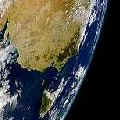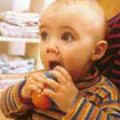傑奇‧艾倫‧朱利安諾博士
泥漿遮蔽了我們的罪惡
清水還給我們自由
毛刷淨化我們的肌膚
微風輕彿過我們的頭髮
陽光照亮我們的臉頰。
天空也將為我們穿上藍色的衣服。
-- 尼可拉‧席波迪奧克斯,10年級,道斯中學,新墨西哥(註:10年級,相當於台灣的高一年級)
每天在這個地球上,數以千計會影響到健康的物質及合成物,充斥在每一個人的生活周遭。

陷入危險的地球。(照片提供:美國太空總署-NASA)
甚至連那些遠在北極圈、幾無技術文明可言的伊努伊特族(註)的原住民,也難逃因隱含在天然食物中有毒化學物所造成的畸形兒及其他的健康問題。而遠在印度及埃及的污染物質,像加氯的殺蟲劑及多氯聯苯,也能經由空氣或海水造成北極圈的污染,甚至連動植物也無一倖免。 (註:Inuit,伊努伊特族人,是愛斯基摩人的一支。在加拿大、格陵蘭一帶,舊名有鄙視之意,現多已改稱。)
有些人想要找出一個方法,在有毒物質開始毒害人類前,就辨識出它們,卻都深受挫折。值得注意的是,美國政府自1978年以來,就一直提供文件來告訴人民,市場上有那些東西會導致癌症。不幸的是,政府只是將這些資訊公佈,卻沒有將這些致命的東西自市場上去除。
國會要求,衛生暨福利部的「國家毒物學計畫」,每兩年公佈一份報告。這份報告必需列出已知及可能致癌的物質。而這些物質是在美國有「一定數量的人」會接觸到。
迄今,這份報告總共出版了九期。第九期包含有218個項目,第十期已經在最後的審稿階段。

長牙時咬的塑膠玩具(teether),含有化學柔軟劑,已知對幼兒的健康有害。(照片提供:美國「綠色和平」)
法律同時也明文規定,這份報告應該提供有關接觸的方式、接觸的人數、以及聯邦法規在減少這些物質危害大眾健康的實施範圍等相關資訊。工業界討厭這些文件,而且他們的代表及律師,努力於將自己的產品排除在名單之外。
國家毒物學計畫則宣稱,這些報告只是純粹的資訊,而且表示,這並不是致癌的危險評估。
該部門繼續表明:「因此,這些物質在報告中被列名,並不表示人們的日常生活中存有風險。這類正式的危險評估,是屬於聯邦、各州及地方衛生管理局及研究中心的權責。」
當然啦,這是為了避免那些造成人民生病傷害的物質,和他們掛勾在一起的政治辭令。
若是經過國家毒物學計畫部門的嚴謹的測試和規範之後,仍被列在報告中,那麼你可以確定這樣物品一定有害。
既然致癌物的報告沒有約束力,那麼人民只好自行將這些物品自生活中去除。
你可以在下列網址,找到這份有關致癌物的完整報告:http://ntp-server.niehs.nih.gov/NewHomeRoc/AboutRoC.html
第十版中所計劃增加的一些物質,可能會令你大吃一驚。就從今天開始吧,一步步減少你接觸的機會吧。

木工廠。(照片提供:美國木頭工藝學院)
木屑
負責管理工作環境安全的「職業健康與安全管理署」,建議將木屑列入第十版中。該機構估計,美國有超過兩百萬人,因工作需要,在磨光傢俱或組裝儲櫃時,經常性地接觸到木屑。因為這些木材是經過包括砷(砒霜)等多種化學物的處理,所以這些木屑是有害、而且致癌。那些在自己家裏製做木材家俱或儲櫃時的人,也一樣會接觸到這些木屑,所以這個發現,將會影響到那一大?有興趣自己裝潢居家環境的美國人。
紫外線
包括像太陽的自然光源或曬黑沙龍的非自然光源,甚至如日光燈等紫外線,都被考慮列入報告。紫外線已知是皮膚癌的原因之一,在美國皮膚癌案例有增加趨勢,所以,關掉日光燈,遠離曬黑沙龍,以及使用防曬油吧。
滑石
將滑石列於報告中後,終於結束了多年的爭辯。數十年來,許多人相信,不論是否含有石棉,滑石粉都會有增加致癌的危險。研究也証實,這兩者間的確有關聯,研究顯示,滑石會造成雌老鼠的氣腫及細支氣管方面的肺癌。最近刊登的研究則指出,在陶器工人致癌主因的分佈中,其中女性的肺癌及卵巢癌的確是和滑石有關聯的。別再等待進一步的證明,現在就開始改用無滑石粉末。
甲基丁香油酚
大多數的人未曾聽過甲基丁香油酚。在果醬,烘烤的食物,不含酒精飲料,口香糖,糖果及冰淇淋的成分中有時可以發現它。它也可以用於香水乳液,洗衣粉及香皂的香味中。研究也明確的證實,亞甲基會使老鼠致癌。
固醇類雌激素
這些賀爾蒙,被廣泛的使用在口服避孕藥及女性後更年期的治療上。國際癌症研究署相信,雌激素對於子宮內膜癌及乳癌,是毫無疑問絕對有關聯的。
氟化乙烯
它用在製造聚氟乙烯的塑膠製品上,就像是嬰兒的乙烯塑膠玩具。把這些玩具馬上拿走,小孩子會把所有東西放入嘴裏,應該只給他們未經化學處理過的木製玩具。
已被列入第九版報告中的致癌物質包括:
氯化乙烯
這個化學物質是用來產生其他化學品的,它也被廣泛使用在保健事業上的醫療用品消毒。在醫院工作的人必需要小心了。
三氯乙烯
數百萬人都會接觸到這致命的化學物,它主要被使用在汽車和金屬工業中,對金屬作蒸汽去污。它也被用來作為黏著劑的成份以及除漆劑、潤滑油、油漆、亮光漆、殺蟲劑以及冷溫金屬清潔劑的溶劑。它也被使用為低溫傳熱媒介以及做為生產藥品,防燃劑及殺蟲劑的中間產物。它也被使用在金屬磷酸化系統,紡織製程,製造聚氯乙與及航空作業上。
三氯乙烯曾經被用來去除咖啡的咖啡因,但如今因為有毒,已經被禁止使用在食物、飲料、寵物飼料、各種藥品及化妝品上。
我們不能低估或輕忽那些被列入或沒列入報告中的物品,廣泛地為害我們的身體及心理。為保衛你自己和家庭,開始行動吧,如果你想要等待聯邦各州或地方政府的行動,那不知道要等到何時。
By Jackie Alan Giuliano, Ph.D.
The mud shall cover our sins
and the water shall wash us free
and the brush shall cleanse our skin
and te wind shall weave our hair
and the sun shall bless our face.
The sky shall clothe us in blue.
-- Nicole Thibodeaux, Grade 10, Taos High School, New Mexico
We are surrounded in our daily lives by thousands of substances and combinations of substances that are affecting the health of nearly every woman, man, and child on Earth.
Our imperiled Earth (Photo courtesy National Aeronautics and Space Administration (NASA))
Even the Inuit native peoples who live in the extreme Arctic, about as far away from technological civilization as you can get, are at risk from birth defects and other health problems from toxic chemicals in their native foods. Pollutants, such as chlorinated pesticides and PCBs, find their way to the Arctic by air or by sea from as far away as India and Egypt. Even plants and animals are being impacted by this toxic load.
Frustration abounds among people everywhere who wish there was a way to identify toxic materials before they start harming people. Remarkably, the U.S. government has been producing a document since 1978 that tells us what substances in the marketplace are known to cause cancer. Unfortunately, the government is only required to publish the information, not to remove any of these deadly substances from the market.
Congress requires that the Department of Health and Human Services' National Toxicology Program (NTP) publish a report every two years. The report contains a list of substances that are either known to be human carcinogens or that may reasonably be anticipated to be human carcinogens. Substances are included if "a significant number of persons" in the United States are exposed to them.
To date, nine editions of the report have been published. The 9th Edition contained 218 entries and the 10th Edition is in the final stages of review.
Plastic teethers contain chemical softeners that have been found to be harmful to the health of young children. (Photo courtesy Greenpeace USA)
The law also states that the reports should provide available information on the nature of exposures, the estimated number of persons exposed and the extent to which the implementation of Federal regulations decreases the risk to public health from exposure to these chemicals. Industries hate this document, and their representatives and attorneys work hard to keep a substance from making the list.
The National Toxicology Program claims that the reports are purely informational and states that they "do not present risk assessments of cancer potential."
The agency goes on to say that "the listing of a substance in the report, therefore, does not establish that such substances or exposure circumstances presents a risk to persons in their daily lives. Such formal risk assessments are the responsibility of the appropriate federal, state, and local health regulatory and research agencies."
This, of course, is the usual political rhetoric to get the National Toxicology Program off the hook for all the sick people harmed by these substances.
If a substance makes it to the document, passing all the conservative tests and standards of the National Toxicology Program, you can bet it causes harm.
Since the Report on Carcinogens carries no regulatory power, people must act for themselves in removing these substances from their lives.
Here are a few of the items on the list. The complete report can be found at: http://ntp-server.niehs.nih.gov/
NewHomeRoc/AboutRoC.html
Proposed to be added to the 10th edition of the Report are some substances that may surprise you. Take steps now to reduce your exposure today.
Woodworking shop (Photo courtesy American Woodworking Academy)Wood Dust
Wood dust
Wood dust is a candidate for the 10th Edition, suggested by the U.S. Occupational Health and Safety Administration, the agency that regulates workplace safety. The agency estimates that at least two million people are routinely exposed occupationally to wood dust worldwide while sanding furniture or constructing cabinets. Because wood is treated with so many chemicals, including arsenic, the dust is harmful and is carcinogenic. People who make wood furniture or cabinets for their own homes are also exposed to the dust. With the huge amount of interest in home improvement projects, this finding affects a large number of Americans.
Ultraviolet Radiation
Broad spectrum ultraviolet (UV) radiation from natural sources like the Sun or unnatural sources like tanning salons or even fluorescent lights is under consideration for listing. UV is known to cause skin cancer and the incidence of skin cancers is rising in the United States. Turn off those fluorescent lights, stay away from tanning parlors, and use sunscreen.
Talc
The presence of talc on the list ends years of controversy. Many people have believed for decades that talc powder - both with and without asbestos - results in increased cancer risk, and studies have confirmed this connection. Studies have shown increased incidences of alveolar/bronchiolar cancers of the lung in female rats. Recently published studies of the distribution and determinants of cancer among pottery workers suggest that talc exposure is associated with lung and ovarian cancer in women workers in this industry. Don't wait for further proof. Switch to using non-talc powders.
Methyleugenol
Methyleugenol is a substance that most people have never heard of, yet can sometimes be found in the list of ingredients in jellies, baked goods, nonalcoholic beverages, chewing gum, candy, and ice cream. It is also used as a fragrance for many perfumes, lotions, detergents and soaps. Studies have shown clear evidence of carcinogenic activity of methyleugenol in rats and mice.
Steroidal Estrogens
These hormores are used widely in oral contraceptives and in post-menopausal therapy for women. The International Agency for Research on Cancer believes that there is a "consistent, strongly positive association between exposure to a number of estrogenic substances and risk of endometrial and breast cancer in women."
Vinyl Fluoride
Used in the production of polyvinyl fluoride which is used for plastics, this material is present in plastic and vinyl toys for babies. Remove them at once from your children. Babies and young children, who put everything into their mouths, should only be given untreated wood toys.
Substances already on the list that were included in the 9th Edition of the Report are:
Ethylene oxide
This chemical is used to make other chemicals, and is also widely used in the health care industry to sterilize medical devices. Hospital workers should beware.
Trichloroethylene
Millions of people are exposed to this deadly chemical, predominantly used for vapor degreasing of metal parts in the automotive and metal industries. It is also used as a component of adhesives and as a solvent in paint strippers, lubricants, paints, varnishes, pesticides, and cold metal cleaners. It is used as a low temperature heat transfer medium and as a chemical intermediate in the production of pharmaceuticals, flame retardant chemicals and insecticides. It is used in metal phosphatizing systems, textile processing, the production of polyvinyl chloride and aerospace operations.
Now banned for use in foods and beverages, it was used to decaffeinate coffee. It has been banned for pet foods, medicine, pharmaceuticals and cosmetics because of its toxicity.
We cannot underestimate or ignore the immense toxic assault on our bodies and minds from these and other substances. Act now to protect yourself and your family. If you wait for action from federal, state, or local governments, you will probably be waiting a very long time.
全文及圖片詳見:http://ens-news.com/ens/apr2001/2001L-04-13g.html
相關資料
1.檢視這份有關只癌物的報告http://ntp-server.niehs.nih.gov/NewHomeRoc/AboutRoC.html
2.查看第九期報告http://ehis.niehs.nih.gov/roc/toc9.html
3.觀察聯合汽車工會如何追蹤這些議題http://www.uaw.org/hs/00/04/hs04.html
4.加拿大職業健康安全中心,是一個很棒的網站,在此可以找到化學物質的資料http://www.ccohs.ca/oshanswers/chemicals/
5.藉由看守世界協網站,瞭解有毒物質問題的重要性http://www.worldwatch.org/.一份目前世界上相關情況的好的摘要http://www.worldwatch.org/alerts/010113.html
6.看看企業如何面對這些被列出來的致癌物質,參考法規執行效率中心http://www.thecre.com/ntp/
7.隨時從衛生研究團體那邊得知最新的衛生議題,該團體是由雷爾夫‧納德於1971年創立http://www.citizen.org/hrg/index.html
8.讓你的孩子遠離哪些物質,參考綠色和平有毒玩具計劃http://www.greenpeaceusa.org/toxics/toxictoystext.htm
9. 閱讀有關危險木材的訊息http://www.osha-slc.gov/SLTC/wooddust/
10. 找出誰是你的國會代表,並且寄電子郵件給他。告訴他所有列在致癌物質報告中的物質種類,都應該要立刻被消除。如果一個強健的經濟體http://www.visi.com/juan/congress/ziptoit.html
11.聯絡布希總統mailto:president@whitehouse.gov. 告訴他必需要停止環境所遭受的打擊。
12.在『行動資產』組織運作的『行動帶來改變』網站上,發表你的意見http://www.workingforchange.com/activism/category.cfm?CategoryId=5, 在這裡你可以容易地將不同的訊息郵寄給真正需要知道的人。
傑奇‧艾倫‧朱利安諾博士,是西雅圖的教師兼作家。他正在準備迎接兒子的出生。他想知道:如何在這個不安的世界,讓兒子能夠健康地成長。請將你的想法、評論與觀察寄到以下的信箱給他:jackie@healingourworld.com,或是造訪他的網頁如下:http://www.healingourworld.com





